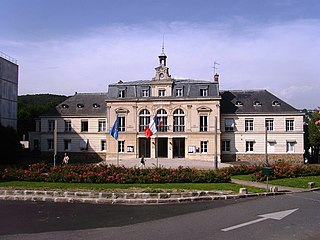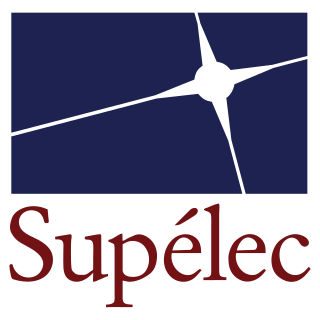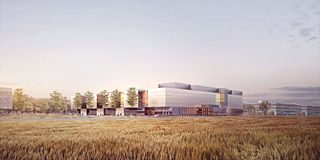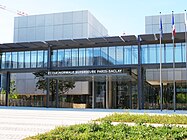
Sorbonne University is a public research university located in Paris, France. The institution's legacy reaches back to the Middle Ages in 1257 when Sorbonne College was established by Robert de Sorbon as a constituent college of the University of Paris, one of the first universities in Europe. Its current iteration was formed in 2018 by the merger of Paris-Sorbonne University and the Université Pierre et Marie Curie.

Orsay is a commune in the Essonne department in Île-de-France in northern France. It is located in the southwestern suburbs of Paris, France, 20.7 km (12.9 mi) from the centre of Paris.

Pierre and Marie Curie University, also known as Paris VI, was a public research university in Paris, France, from 1971 to 2017. The university was located on the Jussieu Campus in the Latin Quarter of the 5th arrondissement of Paris, France. UPMC merged with Paris-Sorbonne University into a new combined Sorbonne University.

The Computer Science Laboratory for Mechanics and Engineering Sciences (LIMSI) was a CNRS pluri-disciplinary science laboratory in Orsay, France.

The Université d'Évry Val-d'Essonne is a French public university located in Évry-Courcouronnes, Île-de-France, and is one of the founding members of Paris-Saclay University.

University of Versailles Saint-Quentin-en-Yvelines is a French public university created in 1991, located in the department of Yvelines and, since 2002, in Hauts-de-Seine. It is a constituent university of the federal Paris-Saclay University.

École supérieure d'électricité, commonly known as Supélec, was a French graduate school of engineering. It was one of the most prestigious grande écoles in France in the field of electrical engineering, energy and information sciences. In 2015, Supélec merged with École Centrale Paris and became CentraleSupélec, a constituent member of Université Paris-Saclay.

Paris-Sud University, also known as the University of Paris — XI, was a French research university distributed among several campuses in the southern suburbs of Paris, including Orsay, Cachan, Châtenay-Malabry, Sceaux, and Kremlin-Bicêtre campuses. In 2020, the university was replaced by the Paris-Saclay University.

The CEA Paris-Saclay center is one of nine centers belonging to the French Alternative Energies and Atomic Energy Commission (CEA). Following a reorganization in 2017, the center consists of multiple sites, including the CEA Saclay site, the Fontenay-aux-Roses site and the sites of Paris, Évry, Orsay and Caen.
The Plateau de Saclay, also called Silicon Valley Européenne, is located north of Essonne and south-east of Yvelines, 20 km south of Paris. It is bounded by the valley of the Yvette to the south and east, and the valley of the Bièvre to the north.

Paris-Saclay is a research-intensive and business cluster currently under construction in the south of Paris, France. It encompasses research facilities, two French major universities with higher education institutions and also research centers of private companies. In 2013, the Technology Review put Paris-Saclay in the top 8 world research clusters. In 2014, it comprised almost 15% of French scientific research capacity.

The Laboratory of Solid State Physics (LPS) is a research institute of the Paris-Saclay University, associated to the National Center of Scientific Research (CNRS) as a joint research unit. It is located in Orsay, France, about 25 km southwest of Paris.

Paris-Saclay University is a combined technological research institute and public research university in Orsay, France. Paris-Saclay was established in 2019 after the merger of four technical grandes écoles, as well as several technological institutes, engineering schools, and research facilities; giving it fifteen constituent colleges with over 48,000 students combined.

Paris Cité University is a public research university located in Paris, France. It was created by decree on 20 March 2019, resulting from the merger of Paris Descartes and Paris Diderot universities, established following the division of the University of Paris in 1970. It was originally established as the University of Paris, but was renamed by decree in March 2022 to its current name. The university headquarter is located in the École de Médecine building, in the 6th arrondissement at boulevard Saint-Germain.

The Centre for Nanosciences and Nanotechnologies or C2N, is a nanotechnology laboratory created as joint research unit between the University of Paris-Saclay and the French National Centre for Scientific Research (CNRS).

The Paris-Saclay Faculty of Sciences or Orsay Faculty of Sciences, in French : Faculté des sciences d'Orsay, is the mathematics and physics school within Paris-Saclay University, founded in 1956. It offers undergraduate and graduate degrees in mathematics, physics and chemistry.

The Polytechnic Institute of Paris is a public technological university located in Palaiseau, France. It consists of six engineering grandes écoles: École polytechnique, ENSTA Paris, ENSAE Paris, École des ponts ParisTech, Télécom Paris and Télécom SudParis.

Gilles Bloch is a French polytechnicien, doctor of medicine and researcher in molecular biophysics, specializing in muscle and brain metabolism. He was director general of research and innovation from 2006 to 2009, then president of Paris-Saclay University between 2015 and 2018, and president of Inserm between 2019 and 2023. Since September 2023, he has served as President of the National Museum of Natural History, France.
The Aimé-Cotton Laboratory or LAC, located in Orsay, is a joint research unit of the French National Centre for Scientific Research (CNRS) and the Paris-Saclay University.

The Sorbonne Faculty of Science and Engineering is the second largest of Sorbonne University's three major faculties, in terms of the number of students enrolled. Formed in 1808 as the Faculty of Science of the University of Paris, it became an autonomous university between 1970 and 2017 under the name of the Pierre and Marie Curie University, before becoming a faculty again when it joined the new Sorbonne University. Marie Curie and Pierre Curie are considered the founders of the modern-day Faculty of Science and Engineering of Sorbonne University.

























